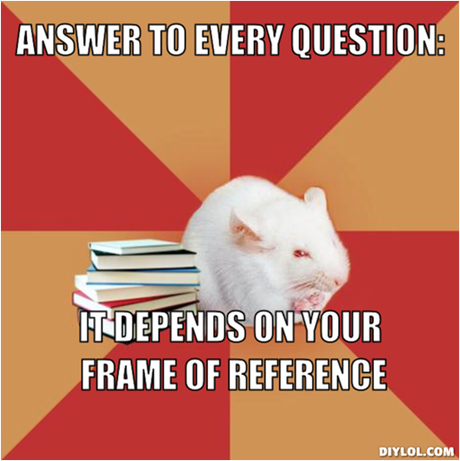Lesson 1: Frames of Reference
Newton’s laws of motion work very well at low speeds compared to c, the speed of light. The theory of relativity on the other hand, explores the effects of motion at high speeds approaching that of the speed of light. Measurement of these effects depends on the frame of reference to which measurements were made. Thus, in order to describe the motion of any object, we must adopt a frame of reference from which to observe the motion. Earth is the most commonly used frame of reference where we assume it to be stationary and measure all positions of a moving object relative to some origin and set of axes fixed on Earth.
The central concept of this chapter is to understand that many different frames of reference exist and that the effects of motion will be seen differently relative to each of these reference frames.
Learning Objectives:
- Understanding that any frame of reference in which the law of inertia holds is referred to as an inertial frame of reference.
- Knowing that a noninertial frame is one that is accelerating relative to an inertial frame.
- Being able to conceptualize the idea that there is no such thing as an absolute inertial frame of reference or absolute velocity; all of these concepts, including simultaneity are relative.
The following video can be shown as a hook to introduce special relativity:
Review the following concepts using the videos below: the reference frame of Newtonian mechanics, inertial frames of reference and noninertial frames of reference.
|
The following video explains the basic concepts of frames of reference using drawings and may be useful for visual learners:
|
The video below shows students explaining frames of reference in a humorous way using real-world examples.
|

Science major mouse. Retrieved from
http://www.weebly.com/uploads/1/6/3/2/16327360/1363487333.jpg
The following activity can be used to help students begin their study of special relativity:
To consolidate the lesson, have students jot down 3 things they have learned about reference frames today on an exit card.
- Have students separated into groups of four to five and have them imagine a moving truck with a person standing on top of the truck.
- Ask students to imagine that they are standing still on the ground observing the truck with the person speeding by. Assign each group a different question pertaining to what they think the speed of the person would be relative to the ground if the person was moving a) in the same direction as the truck at speed v, b) in the opposite direction of the truck at speed v or c) not moving relative to the truck.
- Have groups share their answers with explanations and then lead a class discussion around each groups solutions.
To consolidate the lesson, have students jot down 3 things they have learned about reference frames today on an exit card.
References
- Hirsch, A., Stewart, C., Martindale, D, & Barry, M. (2011). Nelson Physics 12. Toronto: Nelson Thomson Learning
